Arboretum Tree Care Plan and Standards
Purpose and Arboretum Plan
Trees are an important contributor to Oklahoma State University’s strength and character. Trees enhance personal enjoyment, social connection, health, and quality of life for our students, faculty, staff, alumni, and other members of our Cowboy Family. They reduce air and noise pollution, provide energy-saving shade and cooling, furnish habitat for wildlife, promote pride and quality of place, energize local economy, encourage walkable communities, and enhance aesthetics and property values. The purpose of this document is to ensure a safe, beautiful, and sustainable campus urban forest and assist the University in achieving the goals listed below.
Mission
The Oklahoma State University Arboretum’s primary mission is to support the University in achieving its goals by providing an inviting, appealing, and respected environment to best serve our diverse population and its various functions related to higher education, community outreach, and reflection. In addition, we strive to move forward with best sustainability and conservation practices which will ensure that our Campus Forest and Arboretum continues to serve our Cowboy Family for generations to come.
Vision
OSU strives to become a leader in environmentally sound landscape and urban forestry display. The campus will offer students, faculty, staff, homeowners, visitors, landscapers, and arborists the opportunity to view and get ideas of a wide variety of native and non-native adapted trees and landscape plant material that can grow in the state. The grounds will become an outdoor classroom by identifying, labeling, and computer linking featured campus trees emphasizing the importance of design, selection, planting, care, and diversification to better demonstrate community urban forests and landscapes.
Goals and Objectives
Our tree management goals are to:
- Continue inventory efforts and use the data to assess the health of existing campus trees.
- Increase the university’s overall tree canopy and health through collections planting and protection.
- Utilize the International Society of Arboriculture’s (ISA) best management practices as a guide to maintain campus trees.
- Educate the campus community and public on tree stewardship, selection, and care.
- Celebrate trees on campus via social media posts, tree planting events, and other forestry related events.
- Update the Campus Arboretum Landscape Master Plan and Standards as needed to best reflect known tree care practices that further support tree care and planning.
- Work with student, faculty, staff groups, and our Tree Leadership Board to accomplish these goals.
Implementation
The tree care plan and standards are developed, maintained, reviewed, and updated by Facilities Management’s (FMLS), Landscape Services Department under the direction of the Landscape Services Director and Assistant Director. Other contributors will be: The Campus Tree Leadership Board, Long Range Facilities Planning and related university departments, and select volunteer opportunities. The University Arborist and Facilities Management Landscape Services Department (FMLS) is responsible for implementing practices outlined in this document. University Arborist, Caitlin Gipson’s can be reached via email caitlin.gipson@okstate.edu.
Campus Tree Leadership Board
Board responsibilities are to foster fresh and visionary thinking through appointed leaders networking together to advance and support the OSU Campus’s Urban and Community Forest. Leaders shall include faculty, staff, student, and community representatives. Terms are for three calendar years with an option for reappointment. Terms will be no more than 2 consecutive terms or 6 years. Duties include attending two to three meetings per year and related Arbor Day observance and volunteer activities.
Campus and community representation are as follows:
- Facilities Management Grounds and Landscape Services Manager
- Facilities Management Facility Services
- Long Range Facilities Planning
- Horticulture and Landscape Architecture Department
- Forestry and Natural Resource Ecology Department
- Stillwater Community Representative
- OSU Foundation
- Forestry Club
Tree Care and Maintenance Funds
The University has a budget for landscape maintenance and care, including tree care. This budget is reviewed and approved by University administration annually. Once approved, provisions for continued maintenance and care of the landscape are allocated to the FMLS Department.
Opportunities to support continued beauty and enhancement of the campus forest via gifts and donations can be made to the OSU Foundation through contributions to the Tree Tribute Fund. Financial support will ensure a legacy for others to enjoy the benefits of OSU’s trees through the careful selection, planting, and maintenance. For a donation of $1,800 or more, a metal plate in the shape of bark will be placed on a statue adjacent to the Cowboy Family Tree art piece located at Theta Pond. The Gifts of any amount are appreciated and recognized in our yearly newsletter. To donate, visit the Campus Tributes page.
Campus Arborculture Practices
All tree care practices shall conform to ANSI Z133 and ANSI A300 standards.
Tree Care Selection and Collections Policy
New tree planting selection will focus on diversification, site specific analysis, pedestrian safety, utility location, landscape function, and other features and will be comprised of both native and non-native species, using non-invasive species as best known upon selection. Tree planting sizes will also vary as to necessitate successive generations of tree maturation. Trees to be planted should be premium grade with no defects or damage and obtained from a reliable nursery. As trees are planted on campus, biometrics for each will be added to the digital inventory and Campus Tree Map Layer. Pre-tagging and selection of trees in the nursery setting prior to purchase is encouraged.
A partial list of recommended trees can be found in the OSU Landscape Master Plan
Tree Inventory
A tree inventory using Global Positioning System (GPS) and Geographic Information System (GIS) equipment, software and methods was initiated in 2010 and continues to be maintained. Trees are identified, mapped, and assessed for health and maintenance needs. The inventory allows grounds staff to 1) guide future tree planting by species, 2) label for educational purposes, 3) overlay with utility maps for future planting conflicts, and 4) better maintain individual trees. The inventory is continually updated by the University Arborist as trees are planted and removed with major measurement updates conducted every ten years.
Understanding Tree Growth
It is essential to understand tree growth to better manage and protect each tree that makes up our very important urban forest. There are many misconceptions when it comes to tree growth. Many people envision a trees top and root system to be a mirror image with roots growing deeply into the ground as the tree is tall. The fact is that deep roots are very uncommon in urban trees. The majority of a tree’s root system is found in the top two to three feet of soil. Taproots seldom develop in an urban setting because of compacted urban sub soils, but roots can be very extensive horizontally extending oftentimes two to three times the spread of the branch canopy as noted in Figure 1.
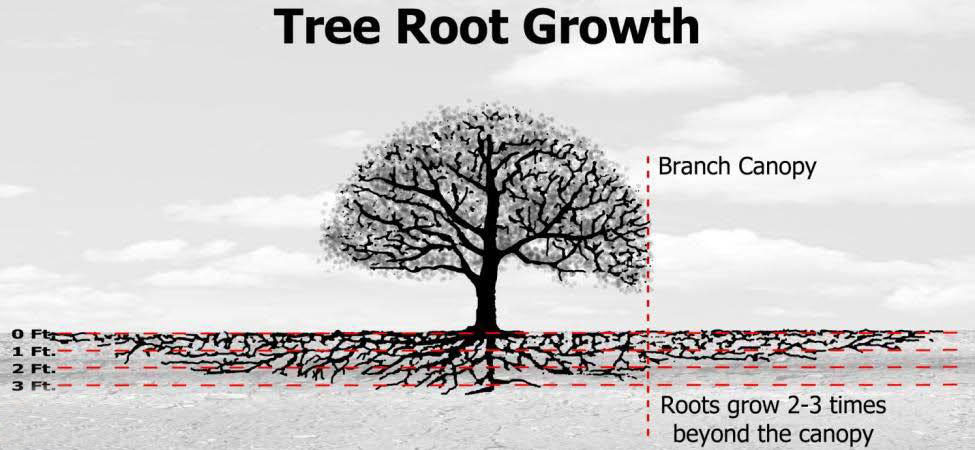
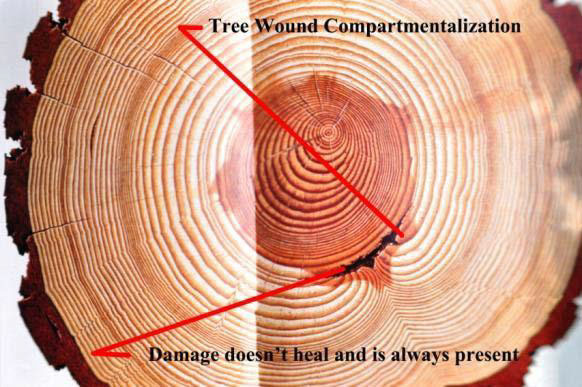
Another mistaken belief is that trees heal from any damage that might occur. The opposite is true. Trees don’t heal, but very simply put, the cells try to compartmentalize the damage to keep it from spreading further. Any damage that occurs is always present, it just hopefully doesn’t spread. Figure 2 shows early trunk damage and compartmentalization over time.
Tree Care Site Preparation
Trees are to be planted in the original soil with no amendments unless trees are planted in a landscape bed. Soils in the entire bed may be amended with a 25 percent or less organic blend and tilled into the original soil. French drains must be used in cases where soils are removed creating a “bathtub effect” or when design grades force the holding of water.
Tree Soil Requirements
In designs where a tree planting area is limited by paved surfaces, guidelines for minimum open soil amounts are recommended. Greater soil volumes are better, but minimum areas are required before more costly options are used. The soil space volume is necessary to sustain the tree roots and allow optimum space for trunk flare growth, both crucial to the longevity and vigor of the tree. This open soil space is based on tree maturity and is not to be covered by hard surfaces such as buildings, sidewalks, pavement, or pavers. Other limitations, such as compaction, high water tables, and poor drainage must also be addressed in the civil design and tree selection stages.
| Tree Size at Maturity | Total Soil Area* |
|---|---|
| SMALL Height less than 30 ft | 10 ft. x 10 ft. |
| MEDIUM Height or canopy 30 - 50 ft | 20 ft. x 20 ft. |
| LARGE Height or canopy greater than 50 ft | 30 ft. x 30 ft. |
Table 1. Minimum Soil Requirements. *Soil depth at 3’ or greater.
Structural Soil
Structural soils are a design option when minimal tree planting soil volumes can’t be met near sidewalks, planting islands, and parking lots. The method uses crushed angular rock (typically 1 inch in diameter) as an aerated substrate for roots to grow while stabilizing the hardscape surface. The rock to soil ratio is about 80% to 20% of the structural volume depending on the method used and can be quite costly. The long-term benefits however justify the initial expenses by reducing concrete failure, mitigating and filtering storm water, and decreasing tree mortality and removal. When properly designed, bid, and constructed, structural soils are compatible with utilities, meet engineering proctor testing requirements, and provide trees with an ample root zone for improved tree vigor and pedestrian enjoyment.
Tree Care Planting
Trees should be planted in holes that are dug no deeper than the root ball, when measured from the bottom of the root ball to the trunk flare at the top of the soil level, and generally 2 - 3 times the diameter width of the root ball. Although on campus we typically plant in holes no smaller in diameter that 6-8 ft. Do not underestimate the positive effect digging a wide hole has on tree establishment. Digging a wide hole is also easier than digging a deeper hole. Lay a shovel or straight board across the top of the planting hole next to the root ball to check its depth in conjunction with the soil grade. In irrigated heavy soils, the trunk flare base should be 1 to 2 inches above the existing soil grade at planting. In poorly drained, waterlogged soils, the trunk flare should be 2 to 4 inches above existing soil grade. If the hole was inadvertently dug too deep, add soil to the bottom of the hole and compact it firmly with your feet. The planting hole’s side walls should be scarred to allow for water and root penetration verses a smooth surface that creates compaction and sealing. Another option in heavy clay soils is to drill holes into the planting hole’s bottom and sidewalls to encourage further root penetration. When digging the planting hole, place fill soil and/or spoils on a temporary holding structure such as a tarp, plywood, container, or RTV bed. This keeps the area tidy by not allowing soil to coalesce with the grass. Grass should be raked back upright after the temporary holding structure is removed.
When planting ball and burlap trees; remove the burlap, twine, nails, and wire baskets before back filling the hole. Girdling will occur if items are left in place, which will shorten the life of the tree. This may be done prior to placement in the hole. However, it is preferred to complete this step after placing the specimen in the planting hole. Sometimes as the burlap comes off, the root ball can become unstable which may not be healthy for the new tree.
When planting container grown trees scarify the sides and base of the root ball to avoid tree girdling and encourage vertical root regeneration out into the soil.
Fill around the root ball with the existing un-amended soil to help stabilize the ball. Break up large soil clumps and do not over pack the soil. Small air pockets are okay and encourage root development.
A water holding reservoir should be constructed with extra soil at a height of 4 to 6 inches depending on the tree size. The reservoir holds water and forces it down to the root system verses running off along the soil surface. The reservoir berm should be removed after one year or when the tree is established. Do no push the excess soil onto the root ball or trunk since it can change the planting depth. Instead, remove the berm soil from the site. A tree planting schematic is found in Figure 3.
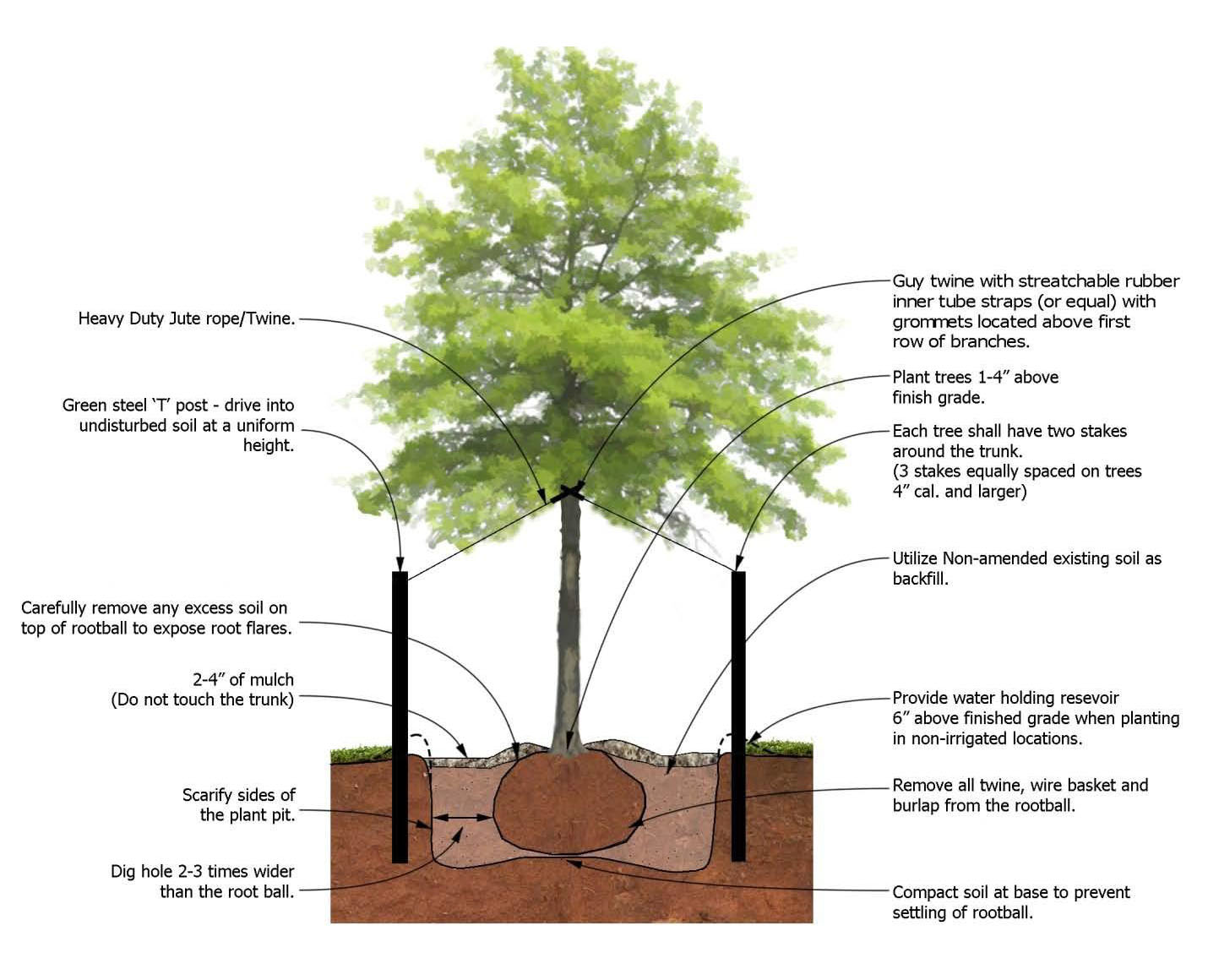
Root Girdling
Observe surface roots as trees mature. Any roots that circle and come in contact with the trunk should be removed. As roots enlarge in size, they can cause girdling to the trunk and limit vascular flow of essential water and nutrients causing trunk or root decay, decline in health and even death. Cut roots at the points where they emerge from the soil and before they embed into the tree trunk.
Mulching
Turf-grass and weeds rob trees of moisture and nutrients, and in some cases inhibit tree growth especially on newly planted trees. Mulch should be used to replace turf and minimize weed seed germination and growth, while helping hold soil moisture, moderate soil temperatures, limit erosion, and keep mowers and string trimmers away. Mulch thickness should range from 2 to 4 inches depending on the product. Angle mulch down to the base of the tree trunk and never apply directly upon the trunk. Contact on the trunk encourages insect, disease, and decay. Recommended mulches include recycled natural products like cottonseed hulls, pine straw, pine bark, pecan hulls, or wood chips. Organic mulches are preferable to inorganic due to their soil enhancing properties. Mulch is an added cost. The benefits far out way the costs in the long run, by minimizing long term weed pulling labor costs, eliminating mechanical damage, and encouraging tree vigor.
Tree Care Staking
Staking, whether trunk or root ball, should only be done when trees are newly planted to mitigate the risk of trees blowing over or breaking.
Tree trunk stakes should not be left on trees for more than eight to twelve months depending on the planting season. Trees four inch caliper and larger should have three green t-post stakes equally spaced used for tying, set at a uniform height. Smaller caliper trees can often times get by with two t-posts. Use heavy duty jute rope/twine to tie from the post guyed to a stretchable rubber inner tube strap with grommets, located above the first row of branches on the tree. Coarse nylon straps, rubber water hoses and similar products should not be used since they are rigid causing tree trunk bruising and wounds.
Jute rope/twine should be snug but not unyielding to allow for some minimal movement of the trunk. Safety caps and ribbon could be used on posts and twine in specific situations to circumvent pedestrian injury.
Root ball stabilization stakes can be used when root balls are firm and hold together, and in locations where trunk stakes are unsightly. Untreated lumber is used horizontally to brace the root ball at the ground level with additional lumber attached and driven into the existing soil out past the planting hole’s backfill as shown in Figure 4. Mulch can be used to cover the lumber which would not need to be removed like a trunk staking system since it will decay within a few years.
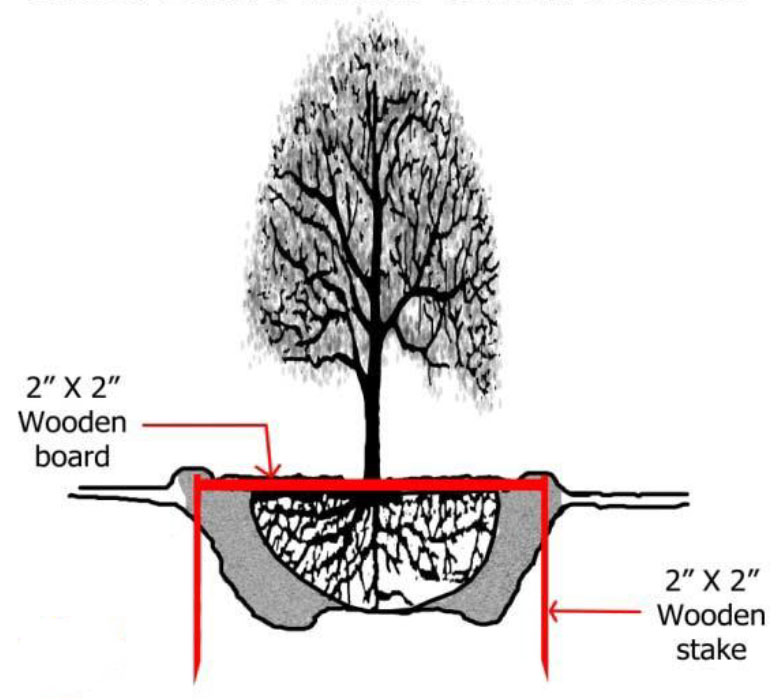
Tree Wraps
Tree wraps are not recommended unless younger thin barked trees like maple and elm would be at risk for sunscald. Tree wrap material should be a waterproof, crinkled, and stretchable paper product. Use the wrap starting at the bottom of the trunk to the first branches. The wrap should be placed on the trunk before the onset of freezing temperatures are first predicted in the fall and removed after the last freeze date in the spring. Wrapping practices should be stopped once trees are established, branches extend, and trunk bark develops typically 2 to 3 years after planting.
Plastic tree wraps used to prevent mechanical damage from sting trimmers and mowers are not necessary. Instead use mulch to limit the need for mechanical equipment to get near the trunk.
Tree Care Fertilzation
Fertilizer should not be applied in the planting hole. Trees planted in lawns will receive plenty of nutrition through lawn fertilization. Trees planted in landscape beds can be broadcast surface fertilized under and just outside the canopy drip line in the spring following planting. Slow-release organic products are a nice choice when applied under the mulch. This can be done as part of a shrub/tree fertilization program according to the product directions. Fertilizer spikes and tree injections are not recommended and should not be used. Soil tests done every couple of years will help guide pH and nutritional needs.
Tree Care Watering and Irrigation
Water trees in thoroughly, immediately after planting, to ensure the entire root ball is saturated. Deep supplemental weekly watering should follow, unless rainfall occurs, until the tree is established which may take one to several years or growing seasons. A drought tolerant tree will not be drought tolerant until it is established, so supplemental watering the first year is a must. Use caution when planting in irrigated turf zones. Depending on the frequency of irrigation watering, trees can either be overwatered or under watered if frequent monitoring doesn’t occur. Some irrigation settings too long or frequent may cause the soil to be constantly saturated, pushing out oxygen and harming roots, even leading to potential death. Trees are also at greater risk of falling from strong winds when soil is kept oversaturated. Lesser settings may not force water down deep enough to the entire root ball base causing shallow root growth, under watering, scorching and death. Check the root ball after watering, not the adjoining soil, to see how far the water penetrates the root ball depth. A small soil probe inserted into the root ball will help determine the watering depth. Sites without automated irrigation will necessitate a water holding reservoir to aid in deep watering, and even then, it may take consecutive fillings to get the water deep enough to reach the root ball depth. A water holding reservoir four to six inches tall will help trap and force the water down to the root ball.
Tree Care Pruning
The most common pruning is to remove dead branches, remove crowded or rubbing limbs, or to eliminate hazards. Trees also are pruned to increase light and air penetration to the inside of the tree's crown or to surrounding landscape. But in most cases, mature trees are pruned as a corrective or preventative measure to promote strong and safe tree growth. Pruning shall not occur without a clear objective. Since each cut has the potential to change the growth of the tree, no branch should be removed without a reason. Heavy pruning can severely stress a tree.
Only properly trained staff should work on minor tree pruning tasks. Minor pruning with minimal cuts can be done as needed throughout the year. Major pruning jobs should be done or coordinated by certified arborist’s whether on staff or contracted out. Major pruning should be done primarily during the dormant season or as needed if damage occurs from inclement weather or hazardous conditions arise.
Pruning should start when trees are young and newly planted to help direct the central leader and avoid weak branch angles. Lower branches should be left and not limbed up for several years to encourage increased trunk diameter growth and tree establishment. The exception would be branches below the union of grafted trees. Mulch to the tree canopy edge, should limbs be in the way of mowers.
Older trees should be monitored for hazardous limb removal and naturally thinning branches. Proper pruning cuts should be made outside the branch collar. Larger limbs, greater than an inch in diameter, should be removed using the “three cut” method of 1) under, 2) through, and 3) finish cut at the branch collar demonstrated in Figure 5. Do not leave stubs or cut too close when removing branches as noted in Figure 6. More detailed pruning standards can be found through the ISA pruning standards.

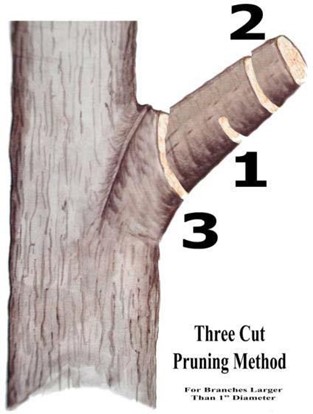
There are generally four specific types of pruning that help trees stay healthy, safe, and beautiful.
Cleaning removes dead, dying, diseased, crowded, weakly-attached, and low-vigor branches from the crown of a tree.
Thinning selectively removes branches to increase light penetration and air movement through the crown and reduces weight on heavy limbs to retain the tree's natural shape.
Raising removes lower branches from a tree to clear space for buildings, vehicles, pedestrians, and views. Raising should not be done during the first 3 to 5 years after planting. Lower branches can actually help increase the trunk diameter more quickly. Not all trees need to be raised however and exhibit natural character and beauty when branches are allowed to remain and grow to the ground, especially in landscapes with plenty of space.
Reduction trims the height or spread of a tree by pruning back the leaders and branch terminals to lateral branches that are large enough to assume the terminal roles (at least one-third the diameter of the cut stem). Reduction is not “topping” or “heading” which is improperly done to drastically shorten tree height using improper pruning methods. Topping is never a proper way to prune trees and should not be practiced on campus.
Integrated Pest Management
Monitor landscape plants for pests on a regular basis with an integrated pest management mindset which includes 1) proper maintenance for pest prevention 2) accurate pest monitoring and identification, 3) setting pest action and beneficial insect thresholds, and 4) using appropriate controls when necessary. The goal is to provide the best planting environment possible based on design and maintenance. Always ensure all other environmental conditions such as air circulation, nutrition, compaction, and supplemental irrigation are managed to ensure positive tree health and minimize pest infestations. Should pest problems occur, allow reasonable time for natural predators to manage the pest infestation. A noticeable level of feeding and disease should be acceptable. Pesticides would be used as a last resort and only when plant survivability is in jeopardy. Use pesticides with the lowest toxicity, preferably natural or organic products, if available. All pesticide label directions should be followed in detail with applicator and pedestrian safety in mind. Grounds staff must be effectively and routinely trained to support this sustainability goal.
Soil Aeration and Compaction
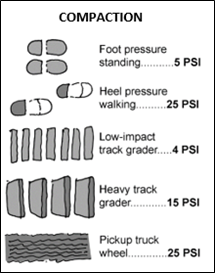
As ninety percent of the fine water and mineral-absorbing roots of a tree are in the upper six to twelve inches of soil, compaction is a serious but sometimes overlooked stressor to the urban forest. Compaction occurs from various sources such as vehicular traffic, construction equipment, and even routine heavy pedestrian traffic. The heavier the equipment, the deeper the compaction to the soil by as much as 3 feet deep. Compaction is shown to reduce the root volume of trees, water permeation, nutrient uptake, and oxygen. The result is poor tree growth, increased pest susceptibility, and even death. Efforts should be taken to minimize vehicles and frequent pedestrian traffic in areas around trees. Some ways to avoid and minimize compaction are:
1) lightly incorporate organic matter into the top 2 to 4 inches of soil
2) prevent vehicles/equipment from operating in the root protection zone as calculated in Figure 8
3) allow construction vehicular traffic during dry periods verses wet soils which is easier to compact
4) spread thick mulch on soil surface or use approved mats for construction traffic to drive on when near trees
5) implement an soil aeration plan using air injection/fracturing equipment on compacted soils.
Herbicides
Herbicides used for turf purposes can have a negative impact on trees causing branch thinning and ultimately tree death. Herbicides should be applied by or under the direction of licensed pesticide applicator staff only.
Herbicides can be absorbed into trees either by roots, leaves, or cambium/bark tissue. Herbicides of any kind should never be applied on surface tree roots! Many turf herbicides can also leach through the grass causing long term harm to tree roots. Turf herbicide labels, whether liquid or granular formulations, should always be thoroughly read to alleviate any potential damage to trees. Things such as label application distances from trees, application frequencies, soil movement and wind drifts should all be identified, clearly understood, and followed before purchase and application. Never increase or over apply recommended rates. Always follow label directions.
Glyphosate herbicides are also very harmful to tree roots, trunks, and branches, and are often sprayed too close to trees. These herbicides are non-selective and will eventually kill trees. Broadleaf herbicides can also drift causing leaf distortion to nearby trees on a short-term basis but are often adsorbed into the leaf potentially causing long term decline and death. Avoid spraying on windy days. When spraying, apply close to the weed target and with minimal pressure to avoid smaller droplet size and drift.
Grounds staff however, are required to instead use a wick application method when working in close proximity to tree trunks and surface roots while avoiding harmful droplets on adjacent trees and plants. An understanding of how shallow and how far tree roots grow is a must to anyone who applies herbicides. Figure 1 is a good visual reminder of typical tree root growth.
Tailgating and Trees
Tailgating is an Oklahoma State athletic tradition. Unfortunately, the heat from grilling and smokers has scalded the bark of several trees and will likely lead to their loss. Heat from generators may cause similar tree injury and loss. Use of generators, grills, smokers, or any other heat producing item is strictly prohibited directly under or near tree canopies. Pruning or breaking tree branches and securing personal items to trees is also strictly prohibited.
Heavy foot traffic from tailgaters congregating under trees can also cause long term harm by soil compaction (Figure 7). Designated trees in risk of soil compaction must be protected by restricting tailgating in the protected root zone. Tailgaters are not to move, cut, or ignore FMLS barriers protecting tree root zones.
Tree Removal
Any trees in jeopardy of removal must first be assessed by the University Arborist and approved by the FMLS Director. Additional certified arborists may also be consulted for tree health assessments. In regard to facility and/or utility construction or renovation, all attempts should be made to the extent possible to preserve and protect healthy, structurally sound trees on the Oklahoma State University campus. The University Arborist must be included in preplanning and design discussions on all new construction or renovation projects to help foster the goals of campus tree stewardship. In all cases, tree removal must be a last resort and only in cases of public safety or hazardous purposes, or when all avenues of construction redesign or protection have been pursued in coordination with the adopted Campus Master Plan. The FMLS Department will be compensated for all lost tree structural value, replanting and new tree establishment costs, and when applicable associated removal costs. Any trees deemed necessary to remove should be carefully dropped with pedestrian and removal crew safety in mind. Trunks and roots should be removed to allow for possible replanting. In other cases where utilities are in close association with the roots, the stump will be ground and later replaced with sod. Stump grindings and limb trimmings will be shredded and composted for future mulch and soil enhancement uses.
Construction Tree Protetion and Education
Even if proper design for tree protection is accomplished, lack of tree protection education for the general contractor and subcontractors can result in tree damage. Harmful construction practices include soil grade changes, equipment soil compaction, porta potty and other chemical spills, all impacting shallow root systems. Mandatory contractor, subcontractor, and project equipment operator training on tree care and protection will be required as part of the preconstruction meetings and conducted by a FMLS Department representative in coordination with the OSU’s Long Range Facilities Planning and Construction & Contract Services Departments.
Attachment 1 will be used in preconstruction meetings to help with contractor tree protection education and expectations. Failure to comply with tree protection guidelines will be spelled out as part of the bid and contract documents on any job that performs work near campus trees.
Tree Protecton Zone
The purpose of the tree protection zone is to protect the entire tree from effects of construction. The above ground parts are protected from mechanical injury while the root system is being protected from compaction and other injury. Remember, many of the roots are located in the upper eighteen to twenty-four inches of soil and ninety percent of the fine water and mineral-absorbing roots of a tree are in the upper six to twelve inches of soil. Tree protection zones will be identified prior to construction work and fenced barriers will be installed accordingly as calculated in Figure 8. Fencing must be installed prior to any equipment arrival on site. Work may not begin until fencing is installed. Fencing shall be galvanized chain link or panels. Plastic fencing, wood frames, or caution tape are not acceptable. No material storage, vehicles, porta potties, employee breaks, or any other activity shall occur at any time within the tree protection zone or fenced barrier. The fence shall be maintained for the duration of the project and shall not be removed without Facilities Management Landscape Services’ permission. Any weed or turf maintenance required inside the fence will be done by the Facilities Management Landscape Services staff.
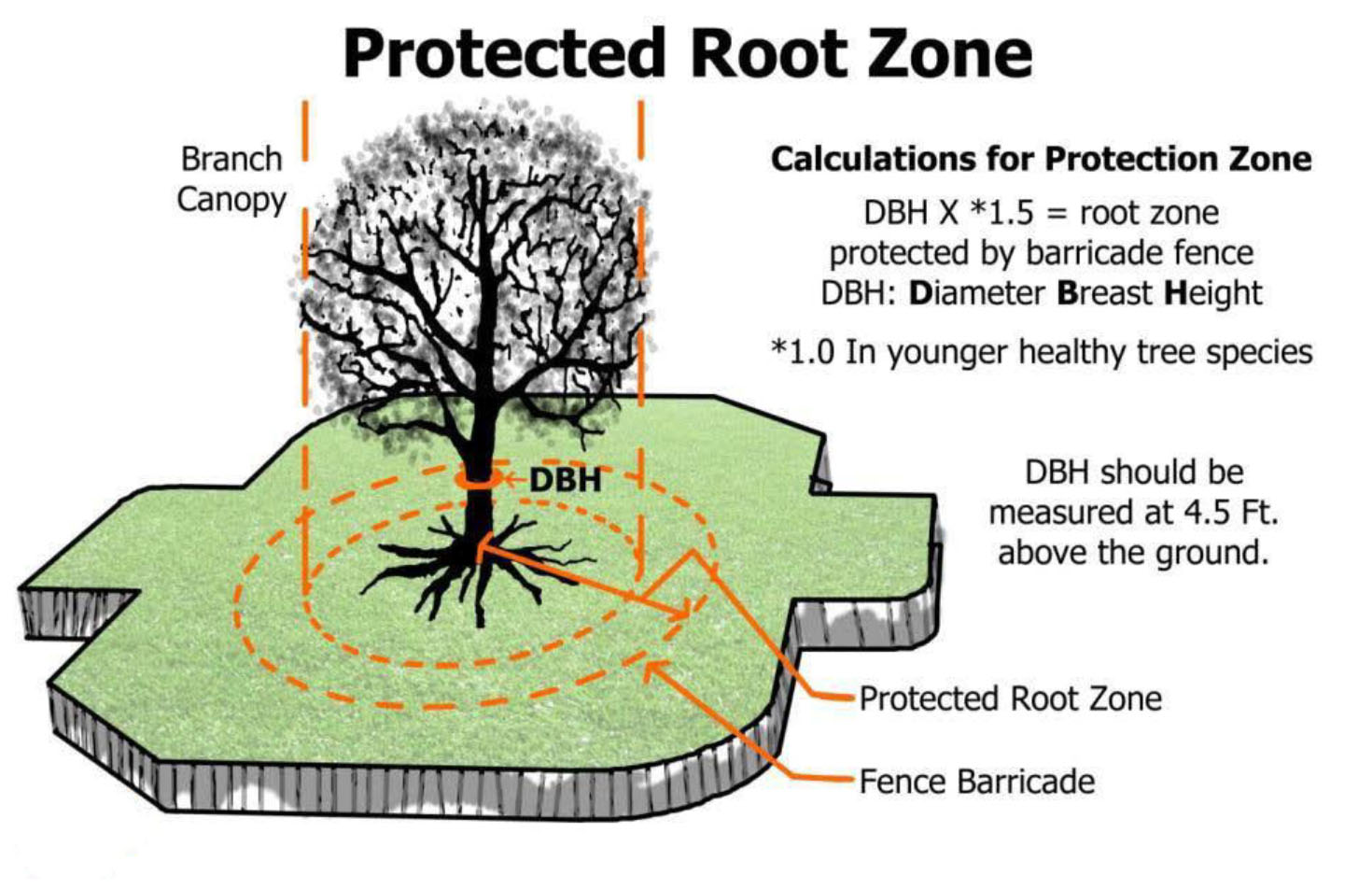
Staff Training
Grounds maintenance and landscape staff must be properly and routinely trained on tree care and maintenance for any plan to be successful. Funding for training is essential and should be provided for topics on proper pruning and safety, planting, tree root growth, trunk damage risks, pesticide application, herbicide damage and risks, mulching practices, and proper watering methods on a yearly basis.
Storm Response and Recovery
The grounds and landscape department has the responsibility to remove fallen trees and branches or prune damaged trees if tornadoes, strong winds, or other weather-related events occur. Essential equipment shall be checked for readiness and safety in accordance to early severe weather notification. It may be necessary to purchase or rent additional equipment. Outside emergency contractors are secured to assist depending on the severity of the storm. Procurement plans must be in place for rapid response. Debris that blocks campus thoroughfares whether vehicular or pedestrian or that poses hazards to the campus community will be cleared first. Future pruning and planting will be addressed and prioritized once the critical needs are met. Pruning needs requiring specialized equipment, not available in house, will also be accessed and prioritized.
Tree Damage Penalties
Damage done to campus trees, whether malicious, a result of construction, or a campus event will not be tolerated. Any persons or groups causing damage to campus trees will be responsible for the costs of repair and/or replacement including labor and may be subject to additional fines and the permanent loss of use of campus facilities or contracted work. Damages will be reviewed and assessed by FMLS and the University Arborist minimally but may include other entities such as Long Range Facilities Planning, University Administration, and OSU Police. The FMLS Department will be compensated for all damage restoration costs, lost tree structural value, and when applicable replanting, new tree establishment, and removal costs.
Prohibited Practices
Trees do not heal from damage to trunks or branches, as noted in Figure 2. Carving on tree trunks, locking bikes or other personal items to trees, breaking or pruning tree branches, nailing signs, hammocking or tying any girdling material to tree trunks where damage or bruising may occur is always prohibited. For hammock use, please use designated metal posts located at Orange Grove, Bennett Hall, University Commons and Stout Residence Hall. Use of generators, grills, smokers, or any other heat producing item is strictly prohibited directly under or near tree canopies.
Tree Terminology
References for tree terminology and identification can be found at the following links: https://shop.arborday.org/treeguide and https://extension.okstate.edu/programs/plant-id/
Communication Strategies
The campus tree care plan and standards are available on the Facilities Management’s website located at OSU Arboretum Tree Care Standards. Construction related tree care standards are part of the construction documents for all future projects coordinated through the Facilities Management and Long Range Facilities Planning. The Oklahoma State University Department of Brand Management will help promote the Tree Care Plan as needed.
References and Recommended Links
Oklahoma Forestry Services http://www.forestry.ok.gov/ucf/
Arbor Day Foundation http://www.arborday.org/
US Forest Service Urban and Community Forestry http://www.fs.fed.us/ucf/
International Society of Arboriculture http://www.isa-arbor.com/
Oklahoma State University Extension https://extension.okstate.edu/
Oklahoma State University Extension Plant ID https://extension.okstate.edu/plant-id/index.html
Urban, James. “Up By Roots: Healthy Soils and Trees in the Built Environment.” Table 1.2.5 Compaction force of vehicles and pedestrians. Pg 35. ISA 2008.
ATTACHMENT 1: PRE-CONSTRUCTION TRAINING FOR TREE PROTECTION
ATTACHMENT 2: TAILGATING AND TREE PROTECTION
